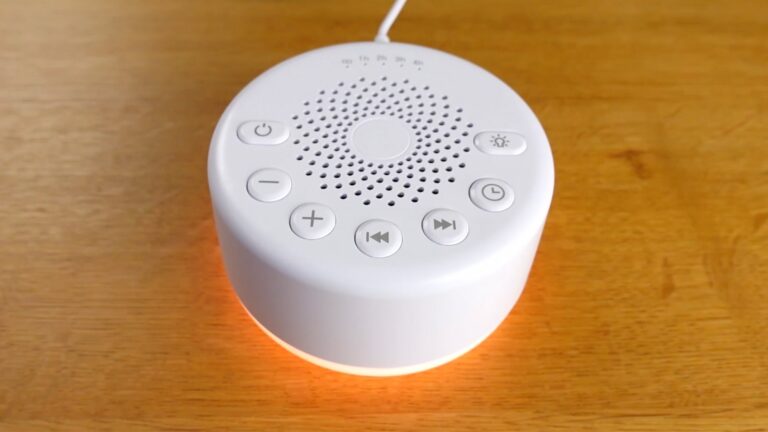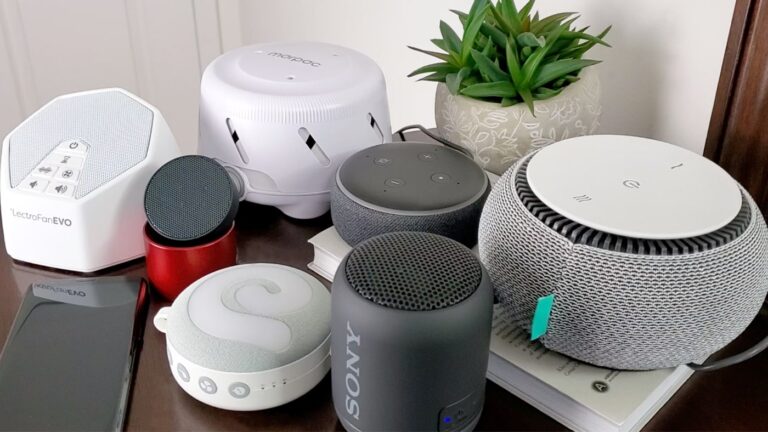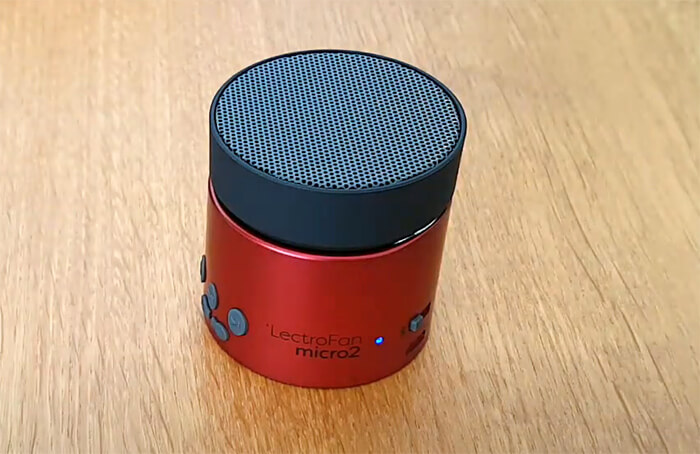Disclosure: My website is reader supported. If you purchase a product after clicking a link, I may receive a commission, at no extra cost to you. Learn more.
Overview
The Sound+Sleep Aquarius white noise machine has some useful features that make it a flexible device, such as the internal rechargeable battery, and Bluetooth input and output.
With 18 water theme sounds, it might appeal to people who find natural sounds like rain and ocean surf relaxing. On the whole, I liked the Aquarius, but was slightly disappointed by what appears to be the mistaken inclusion of someone talking in the background of the waterfall recordings.
Pros
- Modern and sleek design.
- Portable.
- Internal battery.
- 18 water sounds.
- Randomised sounds.
- Wired and Bluetooth headphones compatible.
- Bluetooth speaker function.
- Remote control.
Cons
- Relatively expensive.
- Slow headphones connection.
- Confusing timer LEDs.
- Some sounds are less natural.
- Person talks in the waterfall recordings.
Price
The Aquarius typically costs around $100 on Amazon in the US and £100 in the UK. You might also be able to find it on eBay, which is where I bought mine.
Video transcript / full review
Please note that this is an almost word for word transcript of my video above. I’ve left in the references to listening to the sounds. If possible, I recommend having a listen to those sections as it will give you a better idea of the Aquarius than I can describe in words.
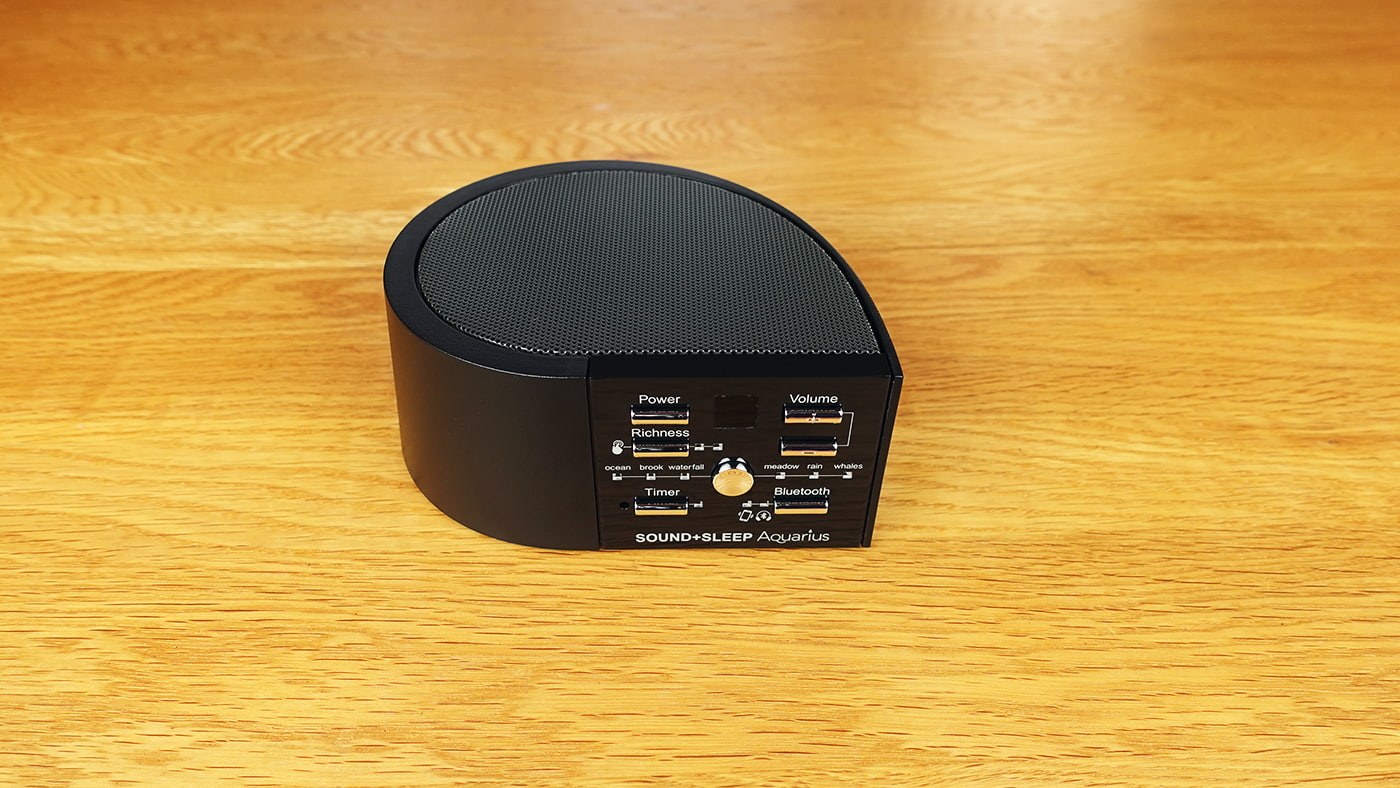
Introduction
The Sound+Sleep Aquarius has more water sounds than any other white noise machine I’ve reviewed. You can also connect via Bluetooth to play your own music through it or listen to the inbuilt sounds on your headphones.
At first glance, there’s a lot to like about the Aquarius. It has some very relaxing sounds, and I like how the richness setting makes them more random. However, there are a few sounds that I really didn’t like because, well, they just sound a bit wrong.
So in a bit, I’m going to play through all the sounds, and you can have a listen yourself. Then I’ll explain which sounds I think let the Aquarius down a bit. But before I do, let’s take a closer look at the device itself.
Price and parts
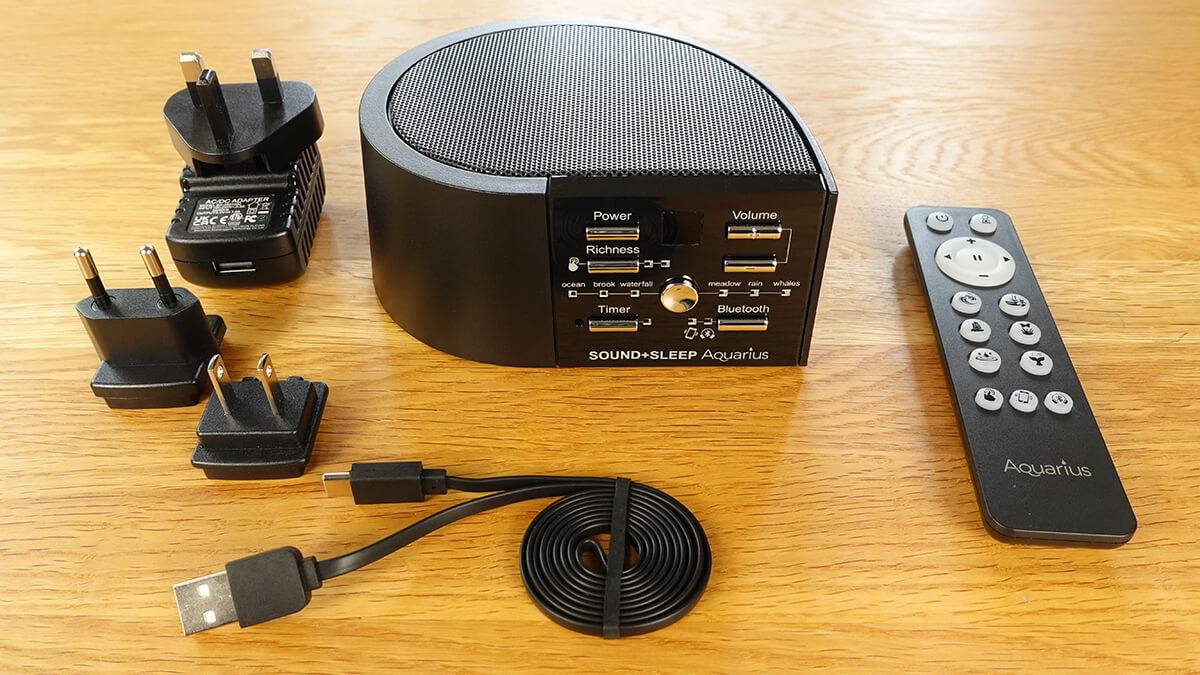
I bought mine from an Adaptive Sound Technologies distributor on eBay in the UK for £99.95, so that does make it one of the more expensive white noise machines.
It arrived in a recyclable cardboard box with a clear instruction manual, remote control, power cable, and power adapters for the US, UK, and EU.
Design
I like the teardrop shape, the upward-facing speaker that helps fill the room with sound, and the modern design. Here you can see it compared to eight other white noise machines I’ve reviewed. Even though it’s not too bulky, it is one of the heavier ones, though. I weighed it at just under 500 grams, which is a little over a pound.
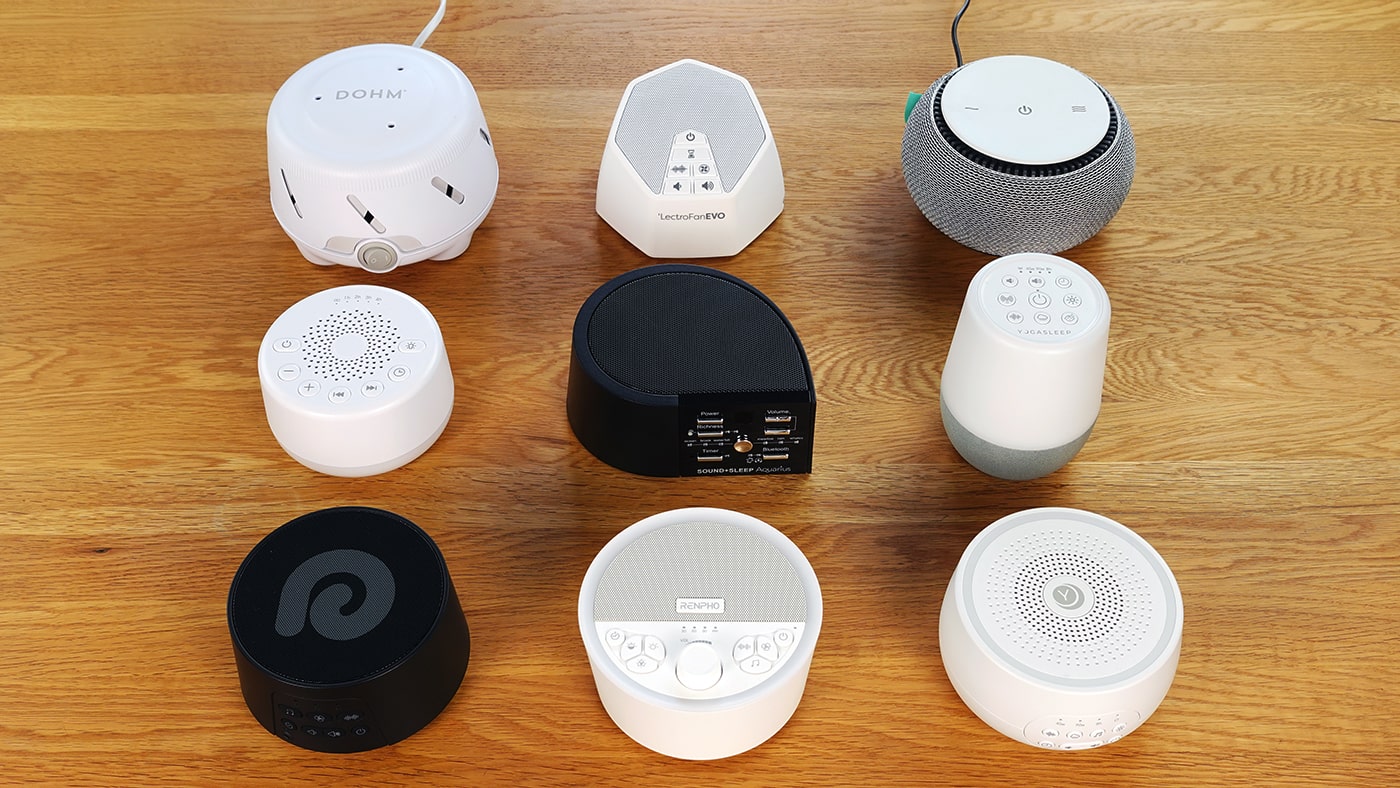
Interface / buttons
Before I go through the features, it’s important to note that all the button LEDs do turn off automatically after 30 seconds, so even though they might appear to strobe sometimes during this video because of my camera settings, they won’t do that during the night.
I like that all the buttons are clearly labeled, which is more user-friendly than the sound machines with tiny symbols.
If you press the middle button, you can cycle through the six main sound categories: Ocean, Brook, Waterfall, Meadow, Rain, and Whales, with an LED to tell you which one you’re on.
If you press the richness button, you can then cycle through the three variations in each category for a total of 18 sounds. Some randomly add extra sounds like sea lions with the Ocean, while others are just different, like the three waterfalls.
In general, this feature is a great concept as it reduces how repetitive the sounds are, especially compared to white noise machines with an obvious one-minute loop.
Auto-off timers
The Aquarius will play continuously unless you press the timer button. You can have 1, 2, or 3 hours, and the timer LED blinks with a different pattern to tell you which one you’re on. Personally, I would have preferred separate LEDs, though, as you have to look very closely to differentiate the blinking patterns.
Bluetooth button
And then there’s a Bluetooth button. If you press it once, you can connect to your own audio device, which I’ll demonstrate later. If you press it again, you can connect to wireless headphones.
Mine always seems very determined to connect to my phone, though, unless I press the button a couple of times, which is a bit annoying.
And then on the side, you have a 3.5 mm headphone jack if you don’t want to connect via Bluetooth, and a USB-C port for the charging cable.
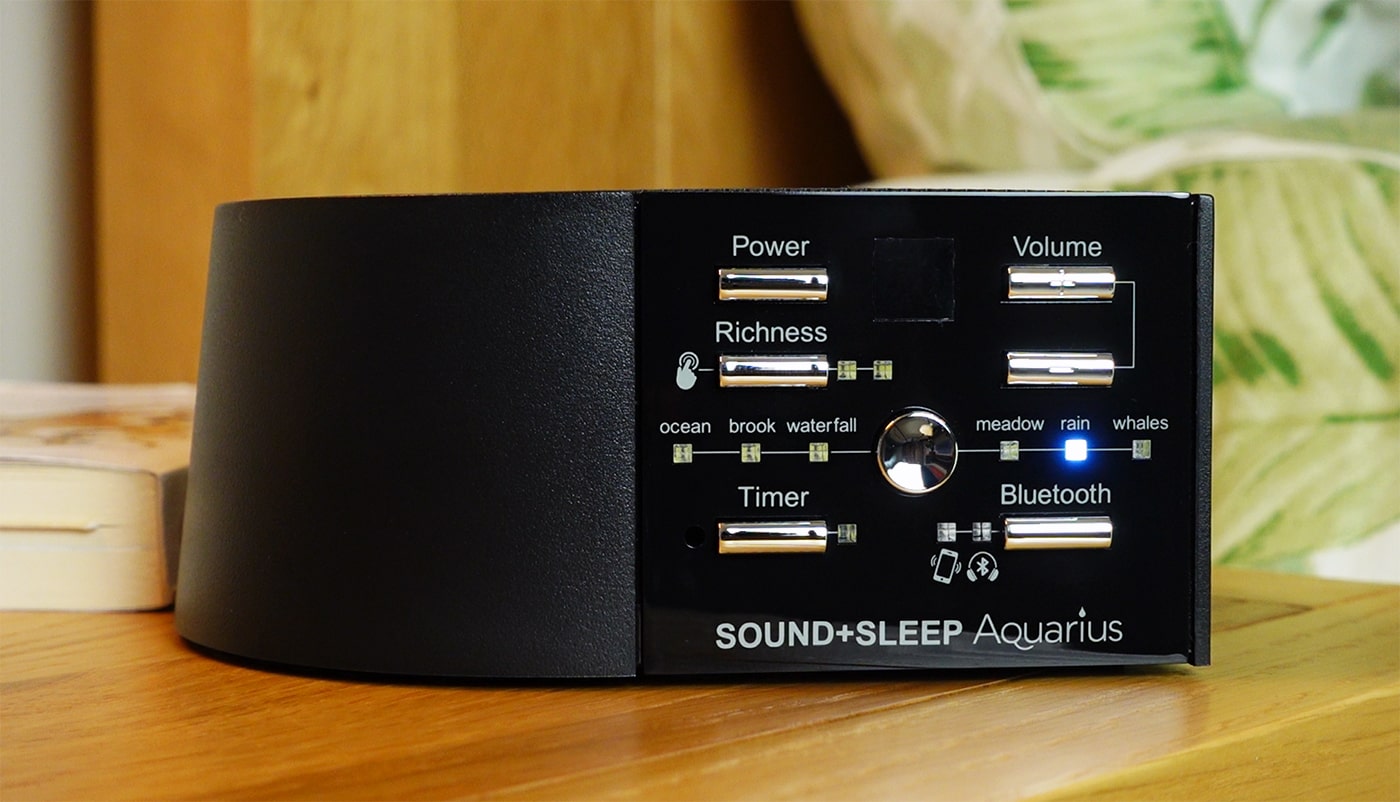
How to power the Aquarius and running costs
One of the best points about the Aquarius is the flexibility in powering it. If you want to, you can keep it plugged in by connecting it with the USB-C power cable and the interchangeable US, UK, or EU power adapters it comes with.
Alternatively, you can make use of the internal rechargeable battery. It takes three and a half hours to charge and will last for over 30 hours playing the inbuilt sounds, which is longer than any other white noise machine I can think of. And this is fantastic as it means you can place it anywhere you like in a room and quickly change the location too.
It’s also very cheap to run. I plugged mine into a power meter with a battery empty for four hours and on a tariff of 28 pence per kilowatt-hour, it didn’t even cost one pence.
The 18 sounds of the Aquarius
Note: This section runs from 3:00 to 6:22 in the video if you’d like to listen to all 18 sound options.
Okay, let’s have a listen to all of the sounds now. Just keep in mind that you’re probably not going to hear all of the richness settings and snippets because it would just make this an incredibly long video, but it should give you an idea of how they sound.
This is how the user manual describes the sounds:
Ocean category
- Ocean waves and lapping water.
- Add stronger waves and gurgling water.
- Also add seagulls and sea lions.
Waterfall category
Three unique waterfalls to choose from.
Meadow category
- Crickets and wind.
- Add bird wings and splashing.
- Also add song birds, bees and frogs.
Rain category
- Rainfall.
- Heavier rainfall plus wind and light Thunder.
- Add more wind and thunder.
Brook category
- Flowing water and wind.
- Add bird wings and splashing.
- Also add song birds and frogs.
Whales category
Three richness settings to choose from and is similar to the ocean category, except that “whale song” is added.
My thoughts on the sounds
Personally, I think the speaker sounds good with clear audio and more bass than average for a white noise machine. I like the ocean options a lot, and the sporadic sea lions and seagulls break up the pattern.
The brook sounds are good too, and my partner has been listening to those a lot this week while working. One of the waterfalls has a nice deep sound, but I didn’t like the other two. The meadow options are good through the speaker, but they are a bit too busy with headphones on.
The rain sounds are probably my favorite, especially the third option with the thunder. It has a nice deep rumbling sound that comes across well through the speaker. As for the whales, it’s a nice idea, but it doesn’t sound particularly natural, in my opinion.
Some issues with the sounds
Okay, it’s time to get real about the sounds. While there’s lots of them that I did like, I’ve got three major problems with them. First of all, I don’t know why they’ve included bees in the meadow. For me, the last thing I want to hear in my house is bees.
Secondly, with the whales, two of the whale sounds have the sound of the whales singing underwater and the ocean surf, crashing waves. To me, that just shouldn’t be possible unless there are flying whales, and I’m pretty sure there’s no flying whales.
However, the worst one is with the waterfalls. In two of them, every couple of minutes, you can hear a guy saying the words “making a splash.” My assumption is that this was the recording crew, and it was missed in editing.
Bluetooth headphones feature
Back to the positives, and I really like how the Aquarius has Bluetooth in and out, which is quite unique for a white noise machine. It can be a bit slow to connect, but I managed with the Apple AirPods Pro 2, the Sony WF-1000 XM4, and the AcousticSheep SleepPhones.
I also tested the noise masking in bed with these headphones and found I could mask most external noise, such as light snoring, traffic, and television.
Volume of the rain sound compared to other white noise machines
Without headphones, the speaker has a reasonable volume range, but it isn’t the loudest I’ve heard. To find out, I used a decibel meter to test the max dBA from one meter away when playing rain at the maximum volume on several white noise machines.
- Dreamegg D3 Pro: 70.5 dBA
- The Yogasleep Dreamcenter: 71.1 dBA
- The Aquarius 71.7 dBA
- The Easysleep 73.3 dBA
- The Renpho 73.5 dBA
- Yogasleep Duet had the loudest rain at 74.2 dBA.
Bluetooth speaker feature
The final feature to talk about is the option to use it as a Bluetooth speaker. This makes it a much more flexible device than the sound machines that only let you play the inbuilt sounds.
And, oddly, even though it can be slow to connect to headphones, I found it connects quickly to my phone. Let’s have a listen first to some music playing through my phone speaker and then the Aquarius.
So music sounds pretty good through the speaker, with more bass than my phone. And if you like radio, podcasts, spoken word also sounds nice and clear.
To give you an example, I just recorded an audio of myself speaking, and first of all, this is it through the phone speaker, and now you’re listening to me through the speaker of the Aquarius. It should be pretty clear and a little bit more bassy than the phone speaker.
Pros and cons
Okay, before I give you my final verdict, let’s take a look at some of the key pros and cons as I see them.
Starting with the pros, it looks modern and sleek. The portable size and internal battery make it flexible for placing in a room. There are lots of water sounds, 18 in total, which is more than any other white noise machine I’ve used. The richness setting adds randomness to the sounds. You can connect to wired or Bluetooth headphones. And it works well as a Bluetooth speaker with decent audio quality.
As for the cons, it’s expensive for a white noise machine. Connecting to headphones via Bluetooth can be slow. The blinking LED pattern to tell you which timer option you’re on isn’t very user-friendly. Some of the richness sounds are a bit unnatural, which you notice more on headphones, such as with the whales, meadow, and waterfall. And in two of the three waterfall options, you can hear a man talking intermittently.
Final verdict
Okay, it’s time for my final verdict. Honestly, this is an unusually difficult one to give. There are so many things that the Aquarius does really well, such as the epically long internal battery life and the Bluetooth in and out.
Some of the sounds are relaxing to listen to and I like the randomness. It also blocks out noise very effectively when you’ve got headphones on, and that’s one of the main jobs of a white noise machine really.
But I do have some gripes with the Aquarius, with the number one thing being the fact that if you listen to two of the three waterfall settings, every couple of minutes, you’re going to hear the same guy say the same thing over and over again, “making a splash”.
Then there are a couple of minor issues, such as the blinking LEDs to tell you which timer setting is on. I think that’s not the most user-friendly decision, and the slightly unreliable Bluetooth connection. But no white noise machine is perfect, so I can live with a couple of smaller issues.
So, as always, you’ll have to make your own mind up as to whether any of the cons I’ve mentioned are potential deal breakers or not. Having said that, if you were particularly looking forward to the idea of the waterfall sounds, I probably wouldn’t recommend this one.
But on the other hand, if you like the idea of ocean surf and rain and thunder, and maybe even singing whales magically flying over the surface of the ocean, it could be a good choice.
Final note about the remote control: I don’t talk about the remote control much in the video as I use it instead. It comes with a watch battery, and works very well. The buttons glow in the dark, which is handy. And it has a good operating distance – I could get it to work from several meters away.

